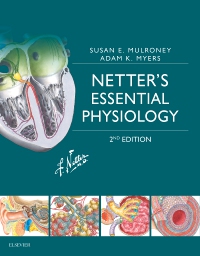
Netter's Essential Physiology Elsevier eBook on VitalSource, 2nd Edition
Elsevier eBook on VitalSource

You may also be interested in: Netter’s Physiology Flash Cards: ISBN 978-0-323-35954-2, the companion flash cards to this book.
Newer Edition Available
Netter's Essential Physiology - Elsevier E-Book on VitalSource
-
- Student Consult eBook version included with purchase. This enhanced eBook experience includes access — on a variety of devices — to the complete text, 8 animations, and new video tutorials. Students can also test their knowledge with additional multiple-choice questions.
- Evolve Instructor Resources, including a downloadable image bank and test bank, are available to instructors through their Elsevier sales rep or via request at: https://evolve.elsevier.com/cs/product/9780323375825?role=faculty
- A brand-new chapter on blood provides increased coverage of immunology.
- Additional "light bulb" boxes highlight interesting memorable details or examples providing enhanced context.
- A greater number of clinical correlations integrate pathophysiology into the content.
- New video clips explaining difficult concepts help to reinforce comprehension of the material.
-
Section 1: Cell Physiology, Fluid Homeostasis, and Membrane Transport
1. The Cell and Fluid Homeostasis
2. Membrane Transport
Section 1 Review Questions
Section 2: The Nervous System and Muscle
3. Nerve and Muscle Physiology
4. Organization and General Functions of the Nervous System
5. Sensory Physiology
6. The Somatic Motor System
7. The Autonomic Nervous System
Section 2 Review Questions
Section 3: Cardiovascular Physiology
8. The Blood
9. Overview of the Heart and Circulation
10. Cardiac Electrophysiology
11. Flow, Pressure, and Resistance
12. The Cardiac Pump
13. The Peripheral Circulation
Section 3 Review Questions
Section 4: Respiratory Physiology
14. Pulmonary Ventilation and Perfusion and Diffusion of Gases
15. The Mechanics of Breathing
16. Oxygen and Carbon Dioxide Transport and Control of Respiration
Section 4 Review Questions
Section 5: Renal Physiology
17. Overview, Glomerular Filtration, and Renal Clearance
18. Renal Transport Processes
19. Urine Concentration and Dilution Mechanisms
20. Regulation of Extracellular Fluid Volume and Osmolarity
21. Regulation of Acid-Base Balance by the Kidneys
Section 5 Review Questions
Section 6: Gastrointestinal Tract
23. Motility Through the Gastrointestinal Tract
24. Gastrointestinal Secretions
25. Hepatobiliary Function
26. Digestion and Absorption
Section 6 Review Questions
Section 7: Endocrine Physiology
27. General Principles of Endocrinology and Pituitary and Hypothalamic Hormones
28. Thyroid Hormones
29. Adrenal Hormones
30. The Endocrine Pancreas
31. Calcium-Regulating Hormones
32. Hormones of the Reproductive System
Section 7 Review Questions



 as described in our
as described in our 